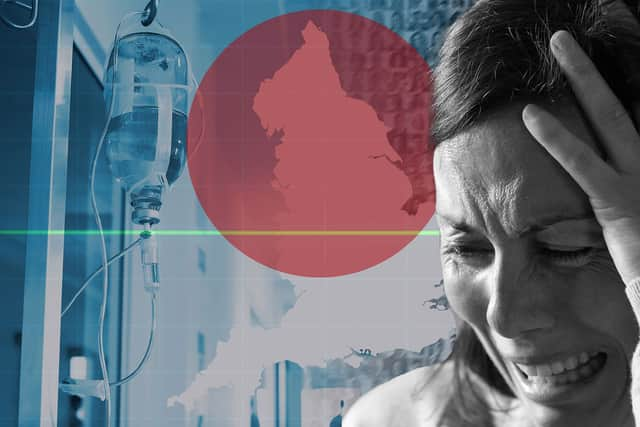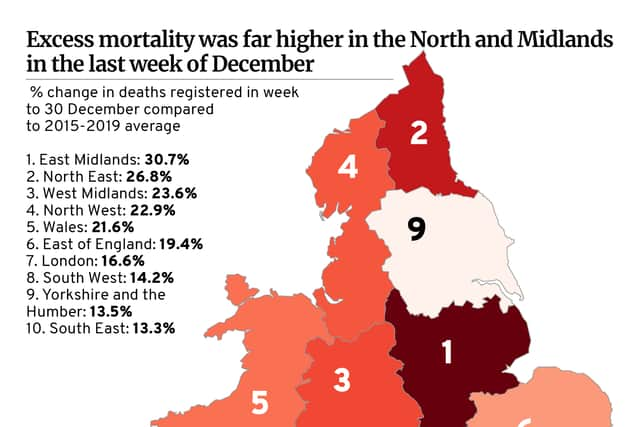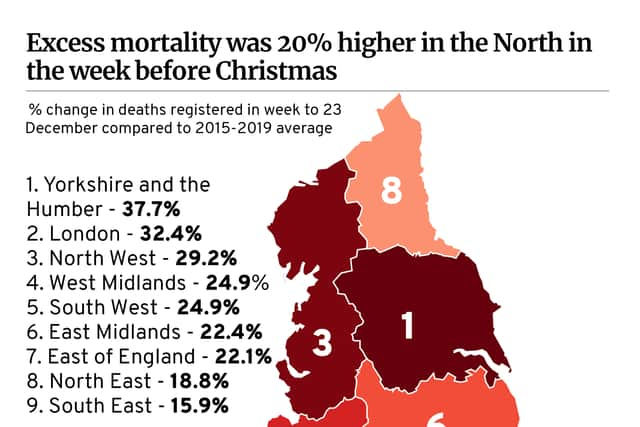Excess deaths England 2022: North and Midlands hardest hit by winter deaths spike - ONS figures explained
and live on Freeview channel 276
Significantly more excess deaths are currently being recorded in the North of England and Midlands compared to the South, with pressure on the NHS “likely” to be a factor, NationalWorld can exclusively reveal.
Labour shadow levelling up secretary Lisa Nandy described the disparity as “unconscionable”, while a health expert from the Institute for Public Policy Research (IPPR) said NationalWorld’s analysis put the reality of health inequality – and the extra burden it puts on the health system in northern regions – into a “stark light”.
Advertisement
Hide AdAdvertisement
Hide AdNationalWorld revealed this week how an extra 424 people were dying every day on average in the seven days to 23 December across England and Wales, with deaths up by 25.8% compared to the average for the same week between 2015 and 2019.
Now our analysis, which is based on weekly death data from the Office for National Statistics (ONS), has also revealed a clear north-south divide across England, with figures released yesterday (10 January) showing the number of additional deaths is a third higher in northern regions compared to southern.
In the four weeks to 30 December, deaths in the North were up by 20.6% compared to the pre-pandemic average, while in the South they were up by 14.7%. The gap is even wider if London is excluded, with deaths up by only 14.3% for the rest of the South. The North West was particularly badly affected, with deaths up a whopping 22.3% compared to before the pandemic. In the Midlands, the figure was 18.9%.
The disparity was also evident over the last eight weeks, covering back to the week ending 11 November, with deaths in the North up by 16.7% compared to 12.1% in the South and 15.3% in the Midlands. The difference is the equivalent of an extra 1,107 northerners and 499 midlanders dying over the last eight weeks, compared to the number that would have died if excess mortality was at the level seen in the south.


Advertisement
Hide AdAdvertisement
Hide AdTwo weeks ago, in the week ending 23 December, it was northern regions recording the sharpest increase in deaths. But in the week ending 30 December it was the Midlands that surged forward with a staggering 27% additional deaths compared to pre-pandemic. That compared to 20.6% in the North and 15.5% in the South.
While the official measure of excess mortality used by the ONS in its national statistics compares deaths in 2022 to the average in 2016, 2017, 2018, 2019 and 2021, NationalWorld has chosen to use the pre-pandemic average (2015 to 2019) to avoid any distortion caused by the disproportionate impact of Covid deaths in northern regions. The ONS does not publish its own comparisons at a regional level, and said it could not comment on the trend NationalWorld uncovered.


While there is a slight north-south gap for excess deaths thoughout 2022 as a whole, the gap has widened in recent weeks.
Concerns have been mounting about the potentially deadly consequences of the crisis gripping the NHS this winter, which doctors have described as the worst they have ever experienced. Hospitals in England have been dangerously busy over the Christmas period, hundreds of thousands of callers have abandoned their attempts to contact NHS 111 amid levels of demand not seen since the start of the Covid pandemic, and tens of thousands of patients have faced delays at A&E after being taken to hospital by ambulance.
Loading....
Advertisement
Hide AdAdvertisement
Hide AdMany health experts also theorise that long waiting lists for elective care, or people having put off coming forward over conditions such as heart problems during the pandemic, are also playing into the rise in deaths in 2022.
Chris Thomas, principal health fellow and head of the commission on health and prosperity at IPPR, said existing regional health inequalities – and the greater strain on services that poorer health can cause – means that northern health systems can feel the strain particularly acutely at times of unprecedented demand.
Loading....
“We saw that during the Covid-19 pandemic where the places that were most likely to experience high levels of infection or high levels of mortality or where the system was particularly under strain in terms of healthcare tended to be places where health inequalities were higher, which was often places like the North East, the North West, Yorkshire and the Humber,” Mr Thomas said.
“What we’ve probably seen is a bit of a reiteration of that trend in the last few weeks while we had that really big infection of the flu and Covid-19 twindemic playing out, so I think it’s fairly likely that the kind of pressures that we’ve seen in the NHS over the last few weeks through the winter are playing into this [excess deaths].”


Advertisement
Hide AdAdvertisement
Hide AdPeople in northern regions have shorter life expectancies and live fewer years before developing disabilities or health problems compared to southern regions, according to figures from the Office for Health Improvement and Disparities.
Commenting on the higher number of excess deaths in the North, Mr Thomas said: “The sad part of it is that it tracks very strongly with what we knew about health inequalities before as well. We tend to see that for almost every health indicator, whether it’s cancer, cardiovascular disease, respiratory disease, that things like excess mortality, preventable mortality, they tend to track to region, there tends to be a very strong north-south divide.”
More attention needs to be paid to regional disparities on issues such as excess deaths, Mr Thomas said, adding, “We’ve had a national discussion about it, but this kind of breakdown is I think very novel.”
Lisa Nandy, Labour’s shadow secretary for levelling up and MP for Wigan, said: “It is unconscionable that the North continues to suffer from such stark health inequalities. After Covid, when communities in the North were locked down for far longer than other parts of the country, tackling the problem is even more vital.
Advertisement
Hide AdAdvertisement
Hide Ad“The Conservatives made narrowing health inequalities a central goal of ‘levelling up’, but these figures show that things are getting worse, not better. Labour will launch the biggest expansion of medical training in history, giving the NHS the staff it needs in every part of the country, paid for by abolishing non-dom tax status.”
The Department for Health and Social Care was approached for comment. It pointed only to comments made by Health Secretary Steve Barclay in the House of Commons earlier this week when challenged on estimates from the Royal College of Emergency Medicine (RCM) that between 300 and 500 people could be dying every week due to delays in emergency or urgent care. Mr Barclay said he had discussed the issue of excess deaths in detail with the chief medical officer and the medical director for NHS England, adding: “The point to note is this is something firstly that has happened internationally. It can’t be ascribed just to one issue as is so often the case.
“Some of the excess mortality will be due directly to Covid itself, albeit that will be a diminishing proportion, but it is also the case that some of the non-Covid excess mortality will be driven by quite a wide combination of factors. I think we have got to be quite cautious when those sort of numbers are bandied around.”
Comment Guidelines
National World encourages reader discussion on our stories. User feedback, insights and back-and-forth exchanges add a rich layer of context to reporting. Please review our Community Guidelines before commenting.
